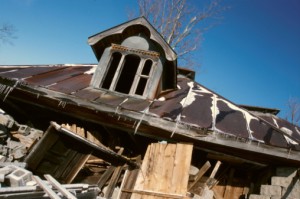Eight Overlooked Roofing Problems
March 25, 2013 10:22 amContrary to what you may believe, you don’t need to wait until a severe storm damages your roof to contact a roofer. Although your shingles may seem to be in perfect shape, your roof could be severely damaged without your notice. Just like most important things, your roof requires regular maintenance to maintain a high performance level.

Instead of calling your roofer after every storm to inspect the health of your roof, know the signs of roof illness. Here are the most common problems to watch out for:
1. Leaking or Excess Moisture: Regardless of the type of roof you may have, leaking is always a problem. This is most likely due to improper installation; if you just had your roof replaced, contact your roofer immediately to report the problem. To prevent leaking, the seams need to be properly glued or heat-welded. For roofs with head laps or backwater laps, leaking is not an uncommon problem.
Leaking generally makes itself known by staining the ceiling with water stains: often these pools turn brown and look like puddles on the ceiling. If you don’t yet see water stains, but have noticed sections of your flooring that become wet following rain, you may need to have your roof inspected.
2. Billowing: Like leaks, billowing occurs from poor installation but can easily be prevented. When there is inadequate fasteners in the base sheet, uncured adhesive, or if shingles were not applied properly, your roof is at risk for billowing or blow-off. When this happens, strong winds are essentially stripping your roof, leaving your house vulnerable to the weather. To prevent this problem, or detect it early, inspect your roof following a windy day: are you missing any shingles or tiles? Are some of them bent upwards from the wind? If so, you may want to contact us.
3. Shrinking: This is a common problem with shingle roofs, where the underlying membrane shrinks due to excessive heat, leaving parts of your roof unprotected. This problem is harder to detect, only evidenced by the pulling of the shingles due to the shrinking membrane or surface deterioration. Since Oklahoma can really blister during the summer months, you may check with us to ensure your roof has you properly protected.
4. Flashing: Flashing is the sealant around things that penetrate your roof, such as vent pipes, sky lights, or a chimney. If not properly installed, this will cause an open seam, allowing moisture in and tiles to blow off. This can be detected by inspecting your roof following a storm: are the tiles surrounding your cooling system especially loose? If so, you may want to contact us for repairs!

5. Ponding Water: Fishing is a great past time, but you don’t want a pond on your roof! Flat areas, or areas near head walls, are a prime spot for water to begin to pool. The water may eventually flood down, but the pooling still takes a toll on your roof. This could be caused by a buildup of debris (so that’s where the football landed!) or even improper drainage of the gutters. Do a thorough inspection yourself before contacting us: is your HVAC unit draining properly? If drains and gutters are clogged, the water has no choice but to damage your roof!
6. Ventilation: The inside of your home can take a toll on your roof, believe it or not. Since hot air rises, the upper levels of your home may be trapping hot air and moisture, which could be causing anything from shingle damage to mildew. Proper ventilation includes vents at the base and top of the roof, allowing warm air to exit. If you’ve been wondering why your electric bill is so high, or why you continuously seem to be sick, your ventilation may be the culprit.
7. Punctures: Wind and hail often leave punctures in your roof, which compromises its ability to protect your home. These punctures can also allow moisture into your home, but they can also be fixed easily. After filling punctures with flashing sealant, check them regularly to ensure they don’t need a new coating. With Oklahoma’s surprising weather, it may be best to invest in high-quality shingles that are resistant to such damage.
8. Maintenance: A lack of general maintenance is the most damaging element, and also the easiest to prevent. Most maintenance tasks do not require a professional roofer, and, while it may cost you a Saturday, will say you in the long run. If you have large tree limbs that overhang your home, begin by trimming them. This will cut back on the debris that could fall, as well as making it harder for critters to crawl up. Just as critters crawling on your roof can cause damage, so can walking on it: most roofers install walkways, which are filled with extra padding to prevent damage to your roof. Locate these before climbing to the top. Finally, ensure you properly clean your gutters and chimney.
Your roof is an important piece of your home: it keeps the ever-changing Oklahoma weather out, so you can keep all of your heat and air in. The key to ensuring your roof lasts is to continually give it check-ups: often the worst roof illnesses started out as a minor sickness that could easily have been prepared. If you have questions regarding the health of your roof, call us today for your free estimate!

